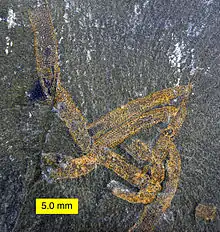Vauxia
Vauxia is an extinct genus of demosponge that had a distinctive branching mode of growth. Each branch consisted of a network of strands. Vauxia also had a skeleton of spongin (flexible organic material) common to modern day sponges. Much like Choia and other sponges, Vauxia fed by extracting nutrients from the water.
| Vauxia | |
|---|---|
 | |
| Vauxia from the Walcott Quarry of the Burgess Shale (Middle Cambrian) | |
| Scientific classification | |
| Kingdom: | Animalia |
| Phylum: | Porifera |
| Class: | Demospongiae |
| Order: | Verongiida |
| Family: | †Vauxiidae |
| Genus: | †Vauxia Walcott, 1920 |
| Species | |
Vauxia is named after Mount Vaux, a mountain in Yoho National Park, British Columbia. It was first described in 1920 by Charles Doolittle Walcott.[2]
Vauxia fossils are found in North America, specifically in the United States and Canada.[3]
References
- Botting, J. (2007). "'Cambrian' demosponges in the Ordovician of Morocco: Insights into the early evolutionary history of sponges". Geobios. 40 (6): 737–748. doi:10.1016/j.geobios.2007.02.006.
- Walcott, C. D. (1920). "Cambrian geology and paleontology IV:6—Middle Cambrian Spongiae". Smithsonian Miscellaneous Collections. 67: 261–364.
- Paleobiology Database
External links
- "Vauxia gracilenta". Burgess Shale Fossil Gallery. Virtual Museum of Canada. 2011.
- Fauna and Flora of the Burgess Shale
This article is issued from Wikipedia. The text is licensed under Creative Commons - Attribution - Sharealike. Additional terms may apply for the media files.